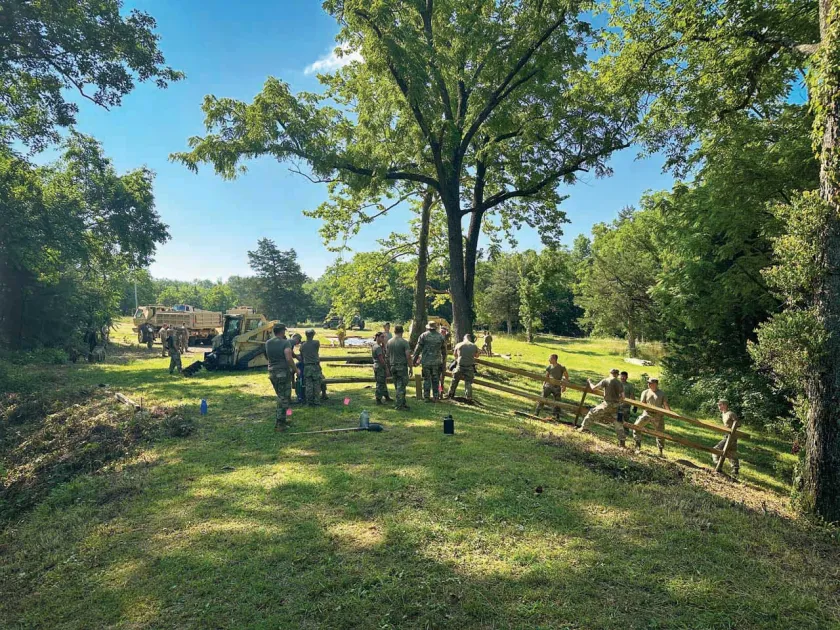Building Access, Preserving History with the Virginia National Guard at Cedar Creek
Jared Herr, jherr@battlefields.org
One hundred sixty-one years after the Battle of Cedar Creek, another military unit arrived on the battlefield in Frederick County, Virginia. Not to fight, but to build. The Virginia National Guard 1033 Engineer Support Company of the 276 Engineer Battalion spent two weeks on the Cedar Creek Battlefield this past July.
The work, all completed on core battlefield land, consisted of constructing two new parking lots, a half-mile trail and a split-rail fence. Previously, no infrastructure was in place to allow easy access for park visitors, cutting off key parts of the battlefield from the public. While the National Park Service provided materials for the troops, the Virginia National Guard brought the equipment. Dozens of soldiers put in approximately 3,100 cumulative volunteer hours over the two weeks.

The work completed by the Virginia National Guard was majorly beneficial for Cedar Creek and Belle Grove National Historical Park beyond providing access to critical parts of the battlefield. The projects were completed at a significantly reduced cost and at a faster pace than would have been possible without their assistance. National Park Service sites often need to compete for funding with other parks and historic sites, and the work by the National Guard soldiers eliminated that process, allowing for the work to be completed well in advance of the battle’s anniversary in October.
"The park still has work to complete, including developing additional interpretive signage and some site work, before the area can be opened to the public,” said Karen Beck-Herzog, site manager at Cedar Creek and Belle Grove National Historical Park. “The plan is a soft launch this fall and a full opening in the spring.”
The Virginia National Guard came to Cedar Creek as part of the Innovative Readiness Training Program, an initiative of the Department of War. The program aims to provide real-world training opportunities for service members in a way that simultaneously benefits the community. Instead of building temporary structures for mission training, soldiers are able to offer a public good while developing practical skills. The National Guard unit that completed the work at Cedar Creek will be able to use their experience when they are deployed to build roads on missions overseas in 2026.
One of the parking lots and the split-rail fence were built on the former site of the Battle of Cedar Creek Campground, a 13-acre property the American Battlefield Trust purchased in 2018. Thanks to the support of their members, as well as the Shenandoah Valley Battlefields Foundation and the HTR Foundation, the Trust acquired the land and demolished nonhistoric structures on the site before transferring it to the National Park Service. The acquisition of the campground property allowed the Trust to reach the historic milestone of 50,000 acres saved throughout the organization’s history. The tract figured prominently in the fierce fighting in October 1864, which gave the Union control over the Shenandoah Valley.
In the fall of 1864, Maj. Gen. Philip Sheridan oversaw a string of Union victories in the Shenandoah Valley, including at Third Winchester, Fisher’s Hill and Tom’s Brook. By mid-October, Confederate Maj. Gen. Jubal Early was determined to strike Sheridan’s army in its camps along the east bank of Cedar Creek. Early executed a surprise attack on the morning of October 19 and drove three Union corps from the field. As Early paused to reorganize, Sheridan arrived after a dramatic ride from Winchester in time to rally his troops and launch a crushing counterattack, from which Early’s forces could not recover. Sheridan’s victory at Cedar Creek extinguished any hope of further Confederate offensives in the Valley and was one of the Union victories in late 1864 that helped ensure President Abraham Lincoln’s reelection that November. Today, the Cedar Creek and Belle Grove National Historical Park help tell the story of the battle to modern visitors, including trails that follow trenches built by Union troops.






